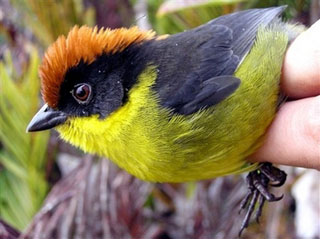Photo of new bird species discovered in Colombia
Photo of new bird species discovered in Colombia
mongabay.com
October 10, 2006 (Originally appeared Oct. 5)
A bird species new to science has been discovered on a remote mountain range in northern Colombia according to Conservation International.
The Yariguies Brush-Finch (Atlapetes latinuchus yariguierum), a large and colorful finch with black, yellow and red plumage, is described in the June issue of the scientific journal Bulletin of the British Ornithologists Club. The bird is named for the Yariguies tribe, the indigenous people that formerly inhabited the mountainous area where it was discovered. The Yariguies are famous for for committing mass suicide instead of submitting to Spanish colonial rule.
 The Yariguies brush-finch. Photo by Blanca Huertas
|
“The description of a new bird is a rare event in modern times,” said Blanca Huertas of Natural History Museum and University College London. “However, this is just the first of several new species that we will be describing from the Yariguíes Mountains. In my own specialist group, butterflies, we have found several new taxa that will be described soon.”
The bird was discovered during an expedition supported by the BP Conservation Programme, a partnership between BP, BirdLife International, Fauna & Flora International, Conservation International and the Wildlife Conservation Society.
Following the discovery of the species and other results from biological surveys in the region, Serranía de los Yariguíes was declared a national park last year by the Colombian government.
Related
Photos of newly discovered species in Brazil’s Amazon rainforest.
Brazil has announced the creation of a Amapa State Forest, a 5.7 million acre Amazon protected area larger than the state of New Jersey. According to Conservation International (CI), “the designation protects a crucial section of the Amapa Biodiversity Corridor of northern Brazil, which includes some of the most pristine remaining Amazon forest.” The Amapa Biodiversity Corridor — which includes a variety of ecosystems including tropical forests, mangrove swamps, savannah, and wetlands — is home to more than 1,700 species of animals and plants, including 430 species of birds, 104 species of amphibians, 124 reptile species and 127 mammal species, including 62 bat species, according to biological surveys conducted by Conservation International (CI) and the Amapa State Institute for Research. At the core of the Amapa Biodiversity Corridor is Tumucumaque National Park, the world’s largest tropical forest park.
This article used information from a Conservation International press release.
.